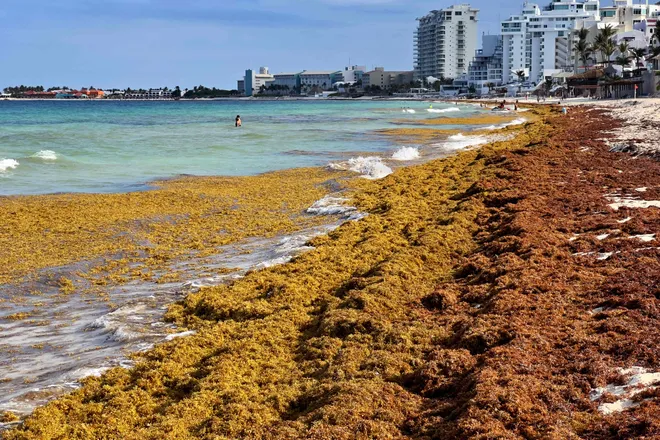A record-size blanket of smelly seaweed could ruin your spring beach trip. What to know.
A massive patchy blanket of sargassum seaweed was seen floating in the tropical Atlantic Ocean via satellite in December but it will be weeks or months before scientists know where or when it could start piling up on beaches.
Satellite images showed the seaweed swath reached a record size for December, more than twice the average size of patches seen in previous Decembers, said Chuanmin Hu, a professor of optical oceanography at the University of South Florida.
But the sargassum – floating on the ocean between the islands along the eastern Caribbean and Africa – is still “very, very remote to Florida, to the U.S. and to the Caribbean,” said Hu.
As part of its growing program to monitor, research and forecast sargassum blooms, the University uses a satellite-based watch system to issue monthly sargassum reports. But they come with a bright red disclaimer that the reports are for scientific purposes and not for predicting bloom conditions on any specific beach.
Researchers are using satellite images to improve their ability to monitor and forecast when and where the sargassum mats could pile up on beaches. That’s increasingly important to local governments throughout the Gulf of Mexico and the Caribbean because the unsightly and rotting plants can drive tourists away and harm local economies.
On land, sargassum begins to rot and produces smelly hydrogen sulfide and ammonia, which can irritate eyes, ears, and noses.
Scientists began documenting an increase in sargassum, a macroalgae, in 2011, and have attributed that at least, in part, to an increase of nutrients, such as fertilizers and other pollution in the water, and climate change.

A growing problem
An increase in the growth of macro and microscopic algal blooms has been documented around the world in freshwater and saltwater bodies. Some scientific reports have linked the increase in blooms at least indirectly to a world made warmer by climate change. For example, studies report seasons have been extended by warmer waters and an increase in extreme rainfall washes more silt into waterways.
Historically, sargassum was primarily located in an area of the western North Atlantic known as the Sargasso Sea. Its range expansion southward was driven by shifting wind patterns and ocean currents that send massive amounts of sargassum into the western Caribbean, Gulf of Mexico and South Atlantic, according to the National Oceanic and Atmospheric Administration. The expanded blooms have been dubbed the "Great Atlantic Sargassum Belt."
The issues with sargassum in the Caribbean and Gulf of Mexico have grown as the blooms expanded in size.
Warming watersBusted boats, stronger storms: Florida fishers face warming waters
Last April, blooms stretched 5,000 miles across the Atlantic, weighing in at an estimated 13 million tons. By May it was piling up on beaches in South Florida and elsewhere.
In December 2023, the floating mass of sargassum in the tropical Atlantic was an estimated 5 million metric tons, compared to a long-term December average of about 2 million metric tons.
The sargassum could reach the Lesser Antilles, on the far eastern side of the Caribbean within a couple of months, Hu said. The very earliest he would expect the sargassum season to arrive on the Mexican Caribbean coast would be late March or early April.
Its size could mean a major sargassum year, but it’s difficult to say for sure what might happen in the coming months, and beachgoers and local officials need not start worrying now about potential impacts, Hu said.
Sargassum mats can grow or shrink from month to month, but there’s no guarantee a large bloom in December would become a record bloom in the spring, he said.
“If we look at the history, they vary a lot,” he said. “At this moment it’s a warning signal for us, for scientists, not a warning signal for the general public.”
A promising forecast
USF researchers hope to improve forecasting for sargassum blooms to pinpoint specific beaches, and to develop ways to reduce the impacts on coastal communities.
“The goal is to be able to put a single beach on alert when a sargassum inundation is imminent, instead of alerting the entire Caribbean,” Brian Barnes, an assistant research professor and a principal investigator, said last fall. “We want to know what happens to those areas that are subject to huge influxes of sargassum."
Their work is part of a five year, $3.2 million NOAA grant for research into sargassum and sargassum forecasting. The grant also is shared by Florida Atlantic University and other institutions.
“A more precise sargassum forecasting system will provide communities in Florida and the Caribbean advanced warning that their beaches may be impacted, and allow them to better prepare for an inundation event,” said Tom Frazer, professor and dean of the university’s College of Marine Science.
Dinah Voyles Pulver covers climate and environment issues for USA TODAY. Reach her at dpulver@gannett.com or @dinahvp.
Disclaimer: The copyright of this article belongs to the original author. Reposting this article is solely for the purpose of information dissemination and does not constitute any investment advice. If there is any infringement, please contact us immediately. We will make corrections or deletions as necessary. Thank you.






